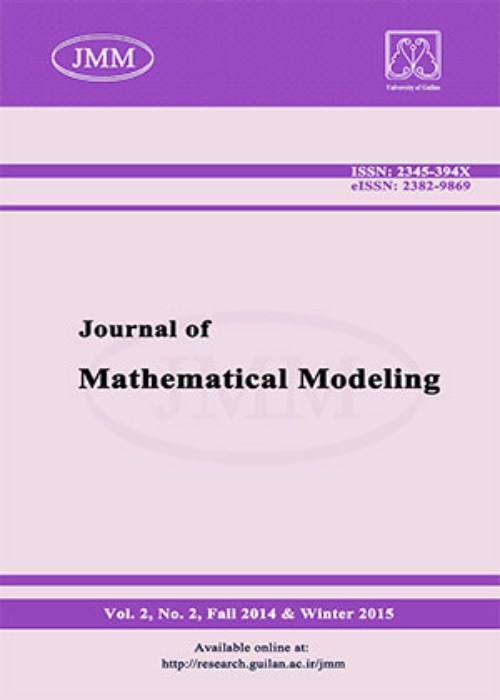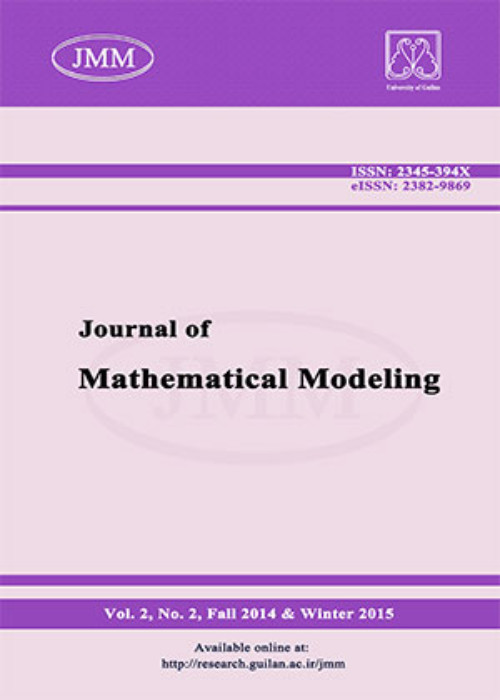فهرست مطالب

Journal of Mathematical Modeling
Volume:11 Issue: 1, Winter 2023
- تاریخ انتشار: 1401/12/27
- تعداد عناوین: 12
-
-
Pages 1-17This paper aims to improve the predictability power of a machine learning method by proposing a two-stage prediction method. We use Group Modeling Data Handling (GMDH)-type neural network method to eliminate the user role in feature selection. To consider recent shocks in Bitcoin market, we consider three periods, before COVID-19, after COVID-19, and after Elon Musk's tweeter activity. Using time-scale analysis, we decomposed the data into different scales. We further investigate the forecasting accuracy across different frequencies. The findings show that in shorter period the first, second and third lag of daily prices and trade volume produce valuable information to predict Bitcoin price while the seven days lag can improve the prediction power over longer period. The results indicate a better performance of the wavelet base GMDH-neural network in comparison with the standard method. This reveals the importance of trade frequencies' impact on the forecasting power of models.Keywords: Forecasting, Machine learning, wavelet, Bitcoin price, GMDH
-
Pages 19-34In this paper, a general class of fractional-order complex-valued bidirectional associative memory neural network with time delay is considered. This neural network model contains an arbitrary number of neurons, i.e. one neuron in the X-layer and other neurons in the Y-layer. Hopf bifurcation analysis of this system will be discussed. Here, the number of neurons, i.e., $n$ can be chosen arbitrarily. We study Hopf bifurcation by taking the time delay as the bifurcation parameter. The critical value of the time delay for the occurrence of Hopf bifurcation is determined. Moreover, we find two kinds of appropriate Lyapunov functions that under some sufficient conditions, global stability of the system is obtained. Finally, numerical examples are also presented.Keywords: Neural Network, fractional ordinary differential equations, Hopf bifurcation, time delay, Lyapunov function
-
Applications of the proximal difference-of-convex algorithm with extrapolation in optimal correctionPages 35-54This paper proposes a proximal difference-of-convex algorithm with extrapolation ($PDCA_e$) based on Dinkelbach's approach for the optimal correction of two types of piecewise linear systems, classical obstacle problems and equilibrium problems, and linear inequalities. Using Dinkelbach's theorem leads to getting the roots of two single-variable functions. Considering the non-convex and level-bounded properties of the obtained problems, we use a proximal difference-of-convex algorithm programming to solve them. The experimental results on several randomly generated test problems show that the $PDCA_e$-generalized Newton method outperforms other methods for both feasible and infeasible cases.Keywords: Proximal difference-of-convex, extrapolation, classical obstacle problem, equilibrium problems, linear inequalities, nonconvex, level-bounded
-
Pages 55-70The existence of different solution approaches that generate approximations to the optimal Pareto frontiers of a multi-objective optimization problem lead to different sets of non-dominated solutions. To evaluate the quality of these solution sets, one requires a comprehensive evaluation measure to consider the features of the solutions. Despite various valuation measures, the deficiency caused by the lack of such a comprehensive measure is visible. For this reason, in this paper, by considering some evaluation measures, first we evaluate the quality of the approximations to the optimal Pareto front resulting from the decomposition-based multi-objective evolutionary algorithm equipped with four decomposition approaches and investigate the related drawbacks. In the second step, we use the concept of Gaussian degree of closeness to combine the evaluation measures, and hence, we propose a new evaluation measure called the quasi-Gaussian integration measure. The numerical results obtained from applying the proposed measure to the standard test functions confirm the effectiveness of this measure in examining the quality of the non-dominated solution set in a more accurate manner.Keywords: Multi-objective optimization, Evolutionary algorithm, Evaluation measure, Pareto frontier, Decomposition
-
Pages 71-81This paper develops a new numerical method of fundamental solutions for the non-homogeneeous convection-diffusion equations with time-dependent heat sources. A summation of the fundamental solutions of the diffusion operator is considered with time-dependent coefficients for the solution of the underlying problem. By the $\theta$-weight discretiztion for the time derivative and selecting the source points and the field points at each time level, the solutions of all time levels are obtained. In addition, the stability of this approach is analyzed by considering $\theta=1$ in numerical results. This method is truly meshless and it is not necessary to discretize any part of the domain or boundary.As a result, this method is easily applicable to higher dimensional problems with irregular domains. In this work, we consider a non-homogeneous convection-diffusion equation (NCDE) in 2D with a regular domain and present some numerical results to show the effectiveness of the proposed method.Keywords: Non-homogeneous diffusion equations, meshfree method, method of fundamental solutions, time-dependent fundamental solutions
-
Pages 83-101Multilinear Discriminant Analysis (MDA) is a powerful dimension reduction method specifically formulated to deal with tensor data. Precisely, the goal of MDA is to find mode-specific projections that optimally separate tensor data from different classes. However, to solve this task, standard MDA methods use alternating optimization heuristics involving the computation of a succession of tensor-matrix products. Such approaches are most of the time difficult to solve and not natural, highligthing the difficulty to formulate this problem in fully tensor form. In this paper, we propose to solve multilinear discriminant analysis (MDA) by using the concept of transform domain (TD) recently proposed in [15]. We show here that moving MDA to this specific transform domain make its resolution easier and more natural. More precisely, each frontal face of the transformed tensor is processed independently to build a separate optimization sub-problems easier to solve. Next, the obtained solutions are converted into projective tensors by inverse transform. By considering a large number of experiments, we show the effectiveness of our approach with respect to existing MDA methods.Keywords: Krylov subspaces, Linear tensor equations, Tensor L-product
-
Pages 103-116We consider a mathematical model of an influenza disease with vaccination and antiviral treatment. This model is expressed by a system of nonlinear ordinary differential equations. We linearize this system by the Newton's method and obtain a sequence of linear systems. The linear systems can be solved by the Chebyshev polynomial solutions, which is a convergence method for numerical solution of linear systems. We solve the problem on a union of many partial intervals. In each partial interval, we first obtain a crude approximation for starting the Newton's method, then solve the problem on current interval by using the lag intervals. An illustration of procedures, we give an algorithm for the initial guess and apply this algorithm for obtaining the total algorithm of the method. We investigate the convergence conditions of the Newton's method for the presented model. In the numerical examples section, we provide some numerical examples to illustrate of the accuracy of the method, and see that the main criterion of the convergence is true for such problems.Keywords: The Newton's method, influenza model, Chebyshev polynomial solutions, long time, nonlinear nonaotonomous ODE
-
Pages 117-132A fractional Bagley-Torvik equation of variable coefficients with Robin boundary conditions is considered in this paper. We prove the existence of the solution which is demonstrated by converting the boundary value problem into a Volterra integral equation of the second kind and also prove the uniqueness of the solution by using the minimum principle. We propose a numerical method that combines the second order spline approximation for the Caputo derivative and the central difference scheme for the second order derivative term. Meanwhile, the Robin boundary conditions is approximated by three-point endpoint formula. It is to be proved that this method is of second order convergent. Numerical examples are provided to demonstrate the accuracy and efficiency of the method.Keywords: Fractional Bagley-Torvik equation, Caputo fractional derivative, Robin boundary conditions, spline method, convergence Analysis
-
Pages 133-156In this paper, a class of Volterra fractional partial integro-differential equations (VFPIDEs) with initial conditions is investigated. Here, the well-known method of lines (MOLs) is developed to solve the VFPIDEs. To this end, the VFPIDE is converted into a system of first-order ordinary differential equations (ODEs) in time variable with initial conditions. Then the resulting ODE system is solved by an LN-stable method, such as Radau IIA or Lobatto IIIC. It is proved that the proposed method is LN-stable. Also, the convergence of the proposed method is proved. Finally, some numerical examples are given to illustrate the efficiency and accuracy of the proposed method.Keywords: Volterra fractional partial integro-differential equation, method of lines, LN-stability, Convergence
-
Pages 157-169The exponential growth of low-cost digital imagery is latterly observed. Images acquired under uneven lighting are prone to experience poor visibility, which may severely limit the performance of most computational photography and automatic visual recognition applications. Different from current optimization techniques, we design a novel partial differential equation-based model to rectify the variable illumination artifacts. In this study, a large number of document samples capturing uneven illumination and low contrast conditions are tested to compare the effectiveness of the proposed local and nonlocal approaches.Keywords: Document image processing, illumination correction, nonlinear diffusion, nonlocal $p$-Laplacian
-
Pages 171-185The integral representation of the optimal exercise boundary problem for generating the continuous-time early exercise boundary for the American put option is a well-known topic in the mathematical finance community. The main focus of this paper is to provide an efficient asymptotically computational method to improve the accuracy of American put options and their optimal exercise boundary. Initially, we reformulate the nonlinear singular integral model of the early exercise premium problem given in [Kim et al., A simple iterative method for the valuation of American options, Quant. Finance. 13 (2013) 885--895] to an equivalent form which is more tractable from a numerical point of view. We then obtain the existence and uniqueness results with verifiable conditions on the functions and parameters in the resulting operator equation. The asymptotic behavior for the early exercise boundary is also analyzed which is mostly compatible with some realistic financial models.Keywords: Non-standard Volterra integral equation, Weakly singular kernel, Numerical treatments, Asymptotic representation, Option Pricing
-
Pages 187-205The primary purpose of this paper is the construction of the Green's function and Sinc approximation for a class of Caputo fractional boundary value problems (CFBVPs). By using the inverse derivative of the fractional order, we can derive the equivalent fractional order Volterra integral equations from CFBVPs, which is considered Green's function. It is approximated by the Sinc-Collocation method. A convergence analysis of the presented method is given. Our approach is applied to five examples. We derive that our approach converges to the exact solution rapidly with the order of exponential accuracy.Keywords: Volterra integral equations, Sinc-collocation method, Green's function, fractional boundary value problems, fractional integrals


